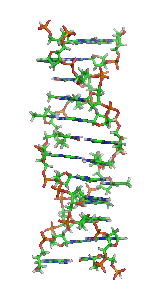
Photo from wikipedia
ALUs contribute to genetic diversity by altering DNA's linear sequence through retrotransposition, recombination and repair. ALUs also have the potential to form alternative non-B-DNA conformations such as Z-DNA, triplexes and… Click to show full abstract
ALUs contribute to genetic diversity by altering DNA's linear sequence through retrotransposition, recombination and repair. ALUs also have the potential to form alternative non-B-DNA conformations such as Z-DNA, triplexes and quadruplexes that alter the read-out of information from the genome. I suggest here these structures enable the rapid reprogramming of cellular pathways to offset DNA damage and regulate inflammation. The experimental data supporting this form of genetic encoding is presented. ALU sequence motifs that form non-B-DNA conformations under physiological conditions are called flipons. Flipons are binary switches. They are dissipative structures that trade energy for information. By efficiently targeting cellular machines to active genes, flipons expand the repertoire of RNAs compiled from a gene. Their action greatly increases the informational capacity of linearly encoded genomes. Flipons are programmable by epigenetic modification, synchronizing cellular events by altering both chromatin state and nucleosome phasing. Different classes of flipon exist. Z-flipons are based on Z-DNA and modify the transcripts compiled from a gene. T-flipons are based on triplexes and localize non-coding RNAs that direct the assembly of cellular machines. G-flipons are based on G-quadruplexes and sense DNA damage, then trigger the appropriate protective responses. Flipon conformation is dynamic, changing with context. When frozen in one state, flipons often cause disease. The propagation of flipons throughout the genome by ALU elements represents a novel evolutionary innovation that allows for rapid change. Each ALU insertion creates variability by extracting a different set of information from the neighbourhood in which it lands. By elaborating on already successful adaptations, the newly compiled transcripts work with the old to enhance survival. Systems that optimize flipon settings through learning can adapt faster than with other forms of evolution. They avoid the risk of relying on random and irreversible codon rewrites.
Journal Title: Royal Society Open Science
Year Published: 2020
Link to full text (if available)
Share on Social Media: Sign Up to like & get
recommendations!